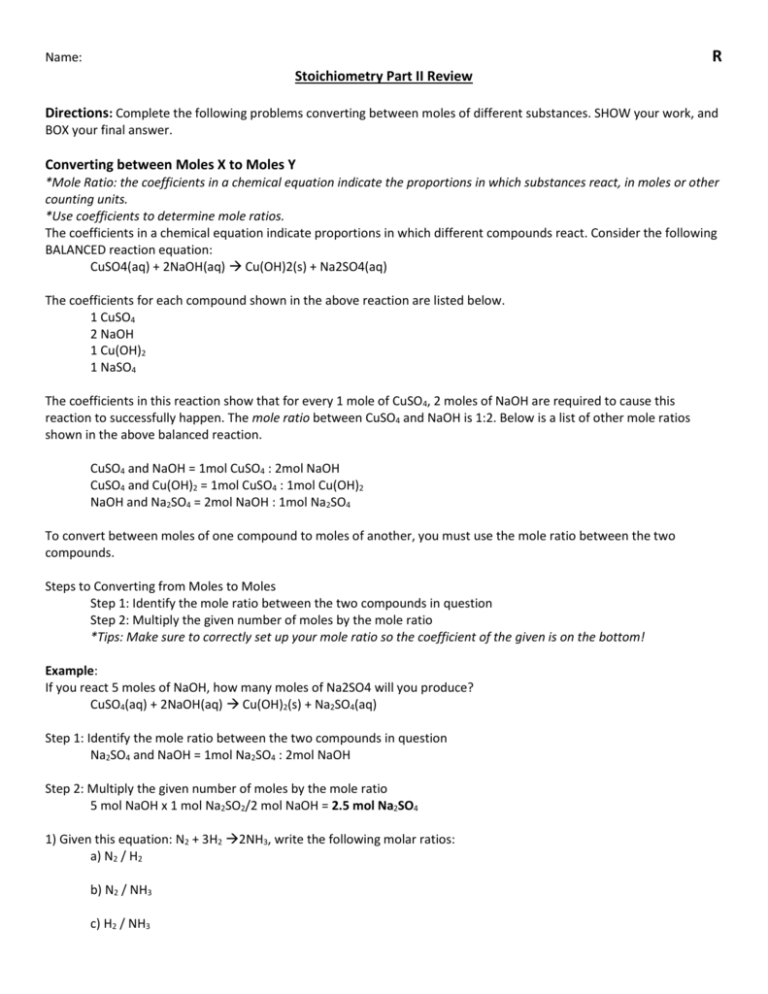Stoichiometry Part II Review
advertisement

R Name: Stoichiometry Part II Review Directions: Complete the following problems converting between moles of different substances. SHOW your work, and BOX your final answer. Converting between Moles X to Moles Y *Mole Ratio: the coefficients in a chemical equation indicate the proportions in which substances react, in moles or other counting units. *Use coefficients to determine mole ratios. The coefficients in a chemical equation indicate proportions in which different compounds react. Consider the following BALANCED reaction equation: CuSO4(aq) + 2NaOH(aq) Cu(OH)2(s) + Na2SO4(aq) The coefficients for each compound shown in the above reaction are listed below. 1 CuSO4 2 NaOH 1 Cu(OH)2 1 NaSO4 The coefficients in this reaction show that for every 1 mole of CuSO4, 2 moles of NaOH are required to cause this reaction to successfully happen. The mole ratio between CuSO4 and NaOH is 1:2. Below is a list of other mole ratios shown in the above balanced reaction. CuSO4 and NaOH = 1mol CuSO4 : 2mol NaOH CuSO4 and Cu(OH)2 = 1mol CuSO4 : 1mol Cu(OH)2 NaOH and Na2SO4 = 2mol NaOH : 1mol Na2SO4 To convert between moles of one compound to moles of another, you must use the mole ratio between the two compounds. Steps to Converting from Moles to Moles Step 1: Identify the mole ratio between the two compounds in question Step 2: Multiply the given number of moles by the mole ratio *Tips: Make sure to correctly set up your mole ratio so the coefficient of the given is on the bottom! Example: If you react 5 moles of NaOH, how many moles of Na2SO4 will you produce? CuSO4(aq) + 2NaOH(aq) Cu(OH)2(s) + Na2SO4(aq) Step 1: Identify the mole ratio between the two compounds in question Na2SO4 and NaOH = 1mol Na2SO4 : 2mol NaOH Step 2: Multiply the given number of moles by the mole ratio 5 mol NaOH x 1 mol Na2SO2/2 mol NaOH = 2.5 mol Na2SO4 1) Given this equation: N2 + 3H2 2NH3, write the following molar ratios: a) N2 / H2 b) N2 / NH3 c) H2 / NH3 2) Given the following equation: 8H2 + S8 8H2S, write the following molar ratios: a) H2 / H2S b) H2 / S8 c) H2S / S8 Directions: Answer each of the following questions using the reaction equation provided. 3) 2NO + O2 2NO2 a. If you have 2 moles of NO how many moles of NO2 can you produce? X _____________________ = _____________ mol NO2 b. If you have 4 moles of O2, how much NO will you need? X _____________________ = _____________ mol NO c. How much NO do you need to make 2.5 mol NO2? X _____________________ = _____________ mol NO 4) 4NH3 + 3O2 4N2 + 6H2O (Try this one without the boxes set up for you!) a. 20 moles of NH3 are needed to produce how many moles of H2O? b. How many moles of N2 will be produced if 3.5 moles of O2 are reacted? 5) Answer the following questions for this equation: 2H2 + O2 2H2O a) What is the H2 / H2O molar ratio? b) What is the O2 / H2O molar ratio? c) Suppose you had 20 moles of H2, how many moles of H2O could you make? d) Suppose you had 20 moles of O2, how many moles of H2O could you make? 6) Given the balanced chemical equation: Br2 + 2NaI 2NaBr + I2 How many moles of sodium bromide (NaBr) could be produced from 0.172 moles of bromine? 7) Given the equation, 8H2 + S8 8H2S: a. How many moles of H2S can be formed from 12 mol H2? b. How many moles of sulfur are needed to form 5 mol H2S? c. How many moles of hydrogen are needed to completely react with 1.7mol sulfur? 8) Given the equation, Cu + 2AgNO3 Cu(NO3)2 + 2Ag: d. How many moles of Cu are needed to react with 3.50 mol AgNO3? e. If 6.25 moles of Ag are created, how many moles of copper were reacted? f. If 5.12 mol Cu(NO3)2 are created, how many moles of silver were created? Converting Between Mass & Moles Moles to Mass 9. What is the mass of 3 moles of KOH? 10. How many grams are in 16 moles of Fe2(NO3)3 Mass to Moles 11. How many moles is 206g of BF5? 12. How many moles is 4.8g of C4H8O4? Climbing Over the Mole Hill *Always refer the mole hill poster if you get lost! Steps to Climbing the Mole Hill Step 1: Calculate the Molar Masses for both the given and the unknown in the problem Step 2: Convert given grams to moles (grams ÷ given’s molar mass) Step 3: Convert from moles of given to moles of the unknown compound (moles x mole ratio) Step 4: Convert moles of the unknown to mass (moles x unknown’s molar mass) 13) Using the following equation: (NH4)2CO3 2NH3 + H2O + CO2 How many grams of water will be formed if you start with 2 grams of (NH4)2CO3? 14) Using the following equation: Mg + H2SO4 MgSO4 + H2 How many grams of H2 will be produced if you start with 3 grams of each Mg? 15) Using the following equation: 2NaCl + H2SO4 Na2SO4 + 2HCl How many grams of Na2SO4 will be produced if you start with 98.1 g H2SO4? 16) Using the following equation: 2 NaOH + H2SO4 2 H2O + Na2SO4 How many grams of sodium sulfate will be formed if you start with 200 grams of sodium hydroxide and you have an excess of sulfuric acid? 17) Using the following equation: 3 C2H3O2H + Al(OH)3 Al(C2H3O2)3 + 3 H2O Determine the mass of aluminum acetate, Al(C2H3O2)3, that can be made if I do this reaction with 125 grams of acetic acid (C2H3O2H). 18) If you start with 10 grams of LiOH, how many grams of LiBr will be produced? LiOH + HBr LiBr + H2O 19) If you start with 45 grams of C2H4, how many grams of CO2 will be made? C2H4 + 3 O2 2 CO2 + 2 H2O 20) Consider this balanced chemical reaction: 2Na2CO3(aq) + CaSO4(aq) Na2S4(aq) + CaCO3(s) a. How many grams of CaSO4 are needed to produce 4500g of CaCO3? b. How many grams of Na2CO3 are needed to produce 4500g of CaCO3? 21) Using the following reaction: BaO + H2SO4 BaSO4 + H2O How much BaSO4 can be formed from 196.0 g of H2SO4?







